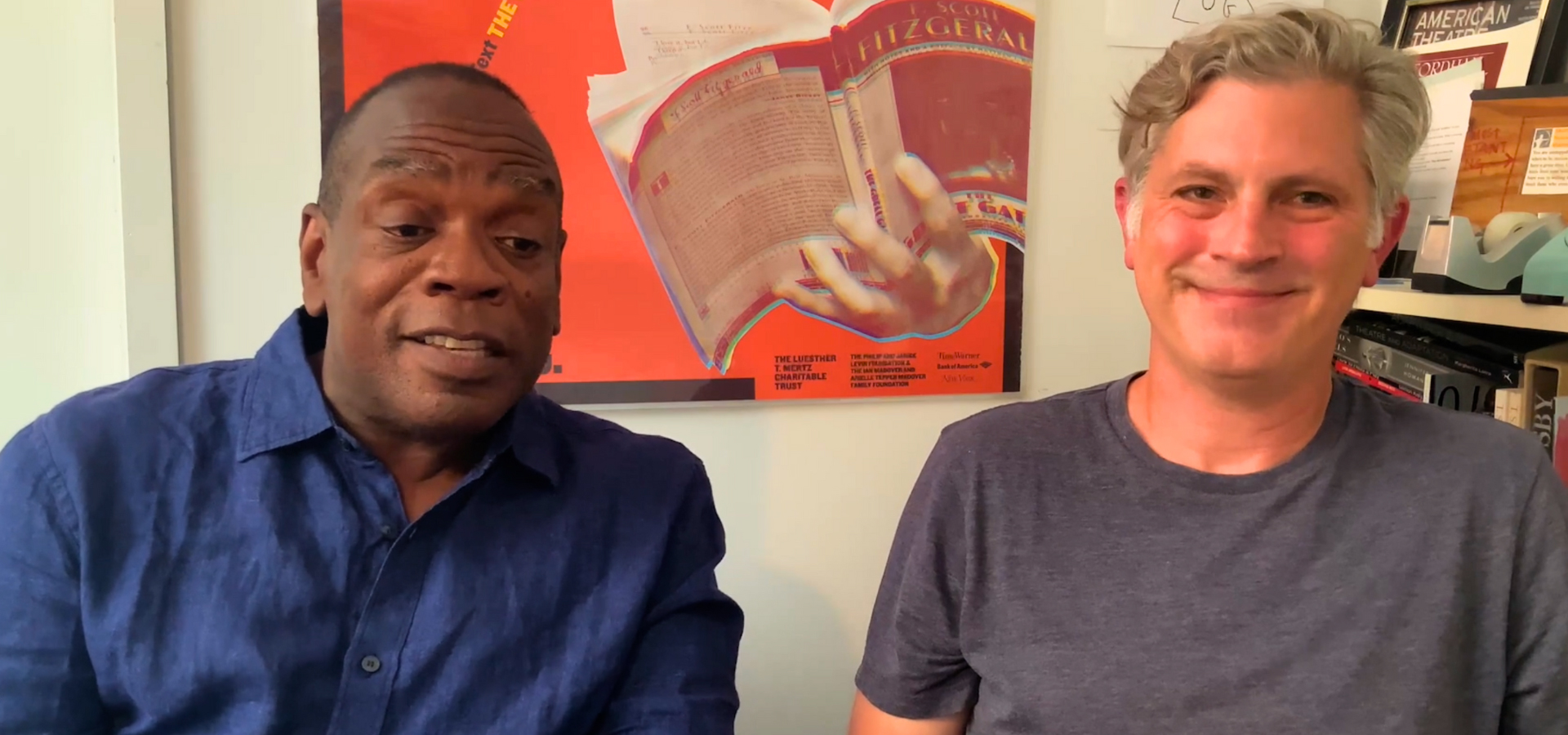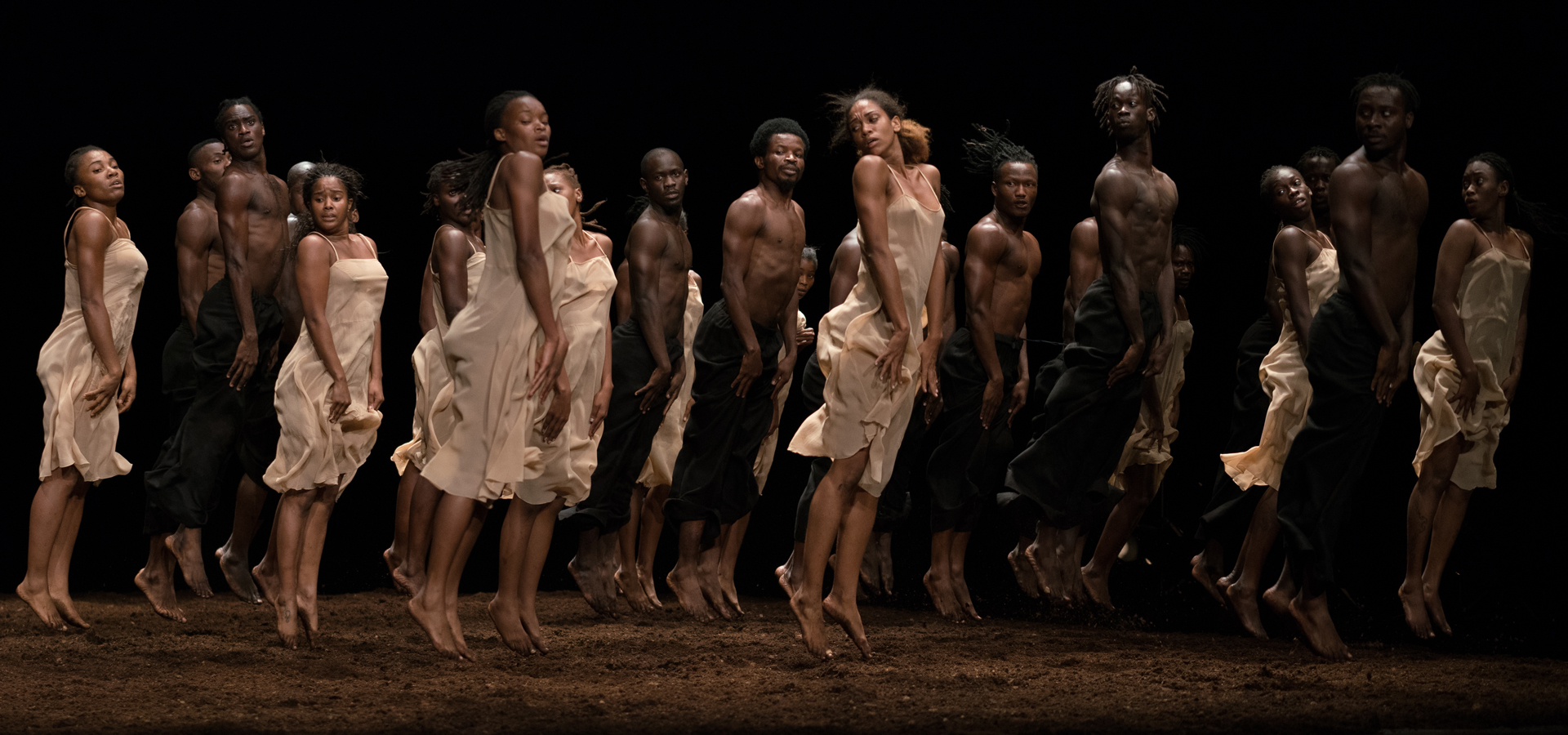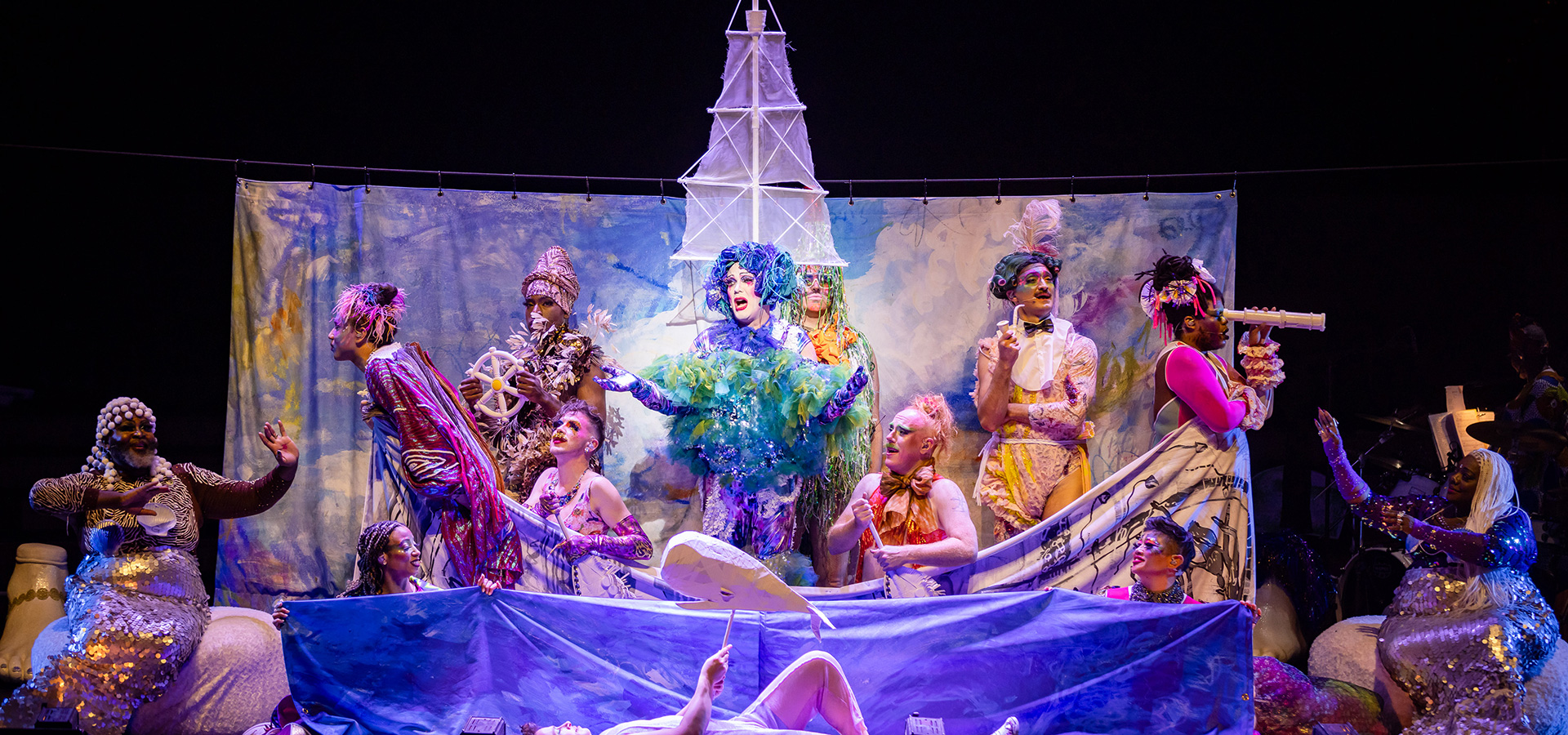
Bark of Millions: Fantasy and Mystery, Rooted in Queerness
“We are part of that same energy, we are the dust from these ancient creative events. And thus we are all tied together.”
By Thomas May, Cal Performances-commissioned writer, critic, educator, and translator
“All we do is sing songs,” says Taylor Mac about Bark of Millions, the new show he and composer Matt Ray have created together with their team of like-minded collaborators. “But there’s something about the ritual of song after song after song inspired by different queer people from world history that is really liberating.”
The link shared by the 55 songs comprising Bark of Millions is the recognition and celebration of queer trailblazers—historical, contemporary, and even from world mythology. Using the Stonewall Riots from the summer of 1969 as a starting reference point, Mac and Ray created one song for each year that has transpired since then.
The world premiere at the Sydney Opera House last October, which marked the 50th anniversary of that landmark venue, was included in the Guardian’s list of Australia’s best stage productions in 2023. Cal Performances presents the West Coast premiere of Bark of Millions (February 23–25, Zellerbach Hall) as one of the highlights of this season’s Illuminations programming on the theme “Individual and Community.”
“We didn’t know what this show would be when we invited Taylor Mac,” says Jeremy Geffen, executive and artistic director of Cal Performances. “But it seemed like the perfect opportunity to introduce the theme ‘Individual and Community,’ which is very much of the moment and informs our national and international dialogue.” Illuminations programming in general, he adds, “was created as a way to reflect on pressing issues of our time through the performing arts, which invite us to become empathetic: you’re quite literally seeing the world through someone else’s eyes. The direct, emotive connection that comes through the performing arts is a powerful tool.”
“My intention is usually just to make something beautiful,” Mac remarks. But his definition of “beautiful” encompasses “the wide range of what beauty can be. It’s not a reductive idea of beauty.” A “fringe benefit” of what such beauty entails in Bark of Millions is that “it feels like we’re purging all of that oppression from growing up queer and then celebrating our survival and our thriving.”
Multifaceted Theater
Mac himself grew up in Stockton in Central Valley, California—he fondly refers to San Francisco as “my first city” (“It always feels like I’m coming back to a better version of home than what I grew up with”)—and gravitated to New York City in his early 20s, shortening his name from Taylor Mac Bower. (Mac also uses “judy” as a pronoun.) Now 50, he has pursued a versatile career as an actor, singer-songwriter, playwright, director, producer, and drag performer. Mac prefers the catch-all term “theater artist” and describes what he does as “an act of consideration and wondering” with regard to other people, to society, to the world around him.
It’s one of the paradoxes of the era we are living through that Mac’s project has become even more necessary in just the last few years, despite the gains in queer rights since the artist came of age. Hundreds of anti-LGBTQ+ bills have been advanced in state legislatures across the US. Murfreesboro, Tennessee even passed an ordinance last summer banning homosexuality. (It was only recently rescinded.) The state is also among those that have passed laws banning drag artists.
“What I’ve noticed from traveling around a lot,” Mac says, “is that societies that don’t embrace queerness have a low-grade depression to them. The more oppressed the culture is, the more depressed the people seem.”
Bark of Millions was not, however, created with the intention of being didactic, of preaching a sermon or imparting a lesson in the history of queer contributions to correct what has been erased from the mainstream. That would in any case call for a more conventional format. Bark is liberating—and subversive—not only in its topic but its presentation.
Ritual is merely one angle from which to consider the dazzlingly multifaceted, abundant theatricality that has become Mac’s signature—as manifested in his largest-scale and most widely known project to date, A 24-Decade History of Popular Music (2016). With its roughly four-hour duration, Bark of Millions is “only” one-sixth of the earlier work’s marathon length but promises to offer a similarly immersive blend evoking aspects of cabaret, musical, song cycle, rock concert, opera, blues jam, nightclub, salon gathering, house party—and, on the “sacred” side of the aisle, a requiem, even a passion play. The list is not exhaustive: surely other performance formats will be elicited according to each participant’s unique experience. Shared with the rest of the audience, however, Bark of Millions is designed to encourage a state of collective trance. Indeed, Mac’s playful subtitle is A Parade Trance Extravaganza for the Living Library of the Deviant Theme.
Mac extends the phenomenon of queerness, which by definition resists being defined, to the work itself. Bark correspondingly revels in being uncategorizeable, irreducible, a joyous hybrid. Such festive polymorphousness—he refers to “everything squished together”—boldly defies the homogeneity of commercial theater. Bark instead resembles something closer to the motley energy of a Pride parade. It’s an analogy Mac likes to make, adding that each of its songs is akin to a float passing by in this extravaganza. This sensibility echoes something of the anarchic, camp-fueled creativity that Charles Ludlam and his co-provocateurs pioneered with the Ridiculous Theatrical Company in New York beginning in the late 1960s.
Niegel Smith, who has collaborated with Mac for the past decade, is one of the show’s trio of co-directors, alongside Mac and Faye Driscoll, Bark’s choreographer. He sums up the one-of-a-kind work as “a highly theatrical event: a community of singers and musicians coming together to get deeper into an experience, a knowledge, a practice of queerness—complete with dance and ritual and a great deal of performance for each other and for the audience.” The songs take shape as scenes that “evoke the deep desire to play inside our queerness but also to share inspiration, to share challenge, to portray worth, to indulge in pleasure, to share beauty.”
A New Queer Canon
Because of its song-based format, Bark of Millions suggests a parallel with A 24-Decade History of Popular Music, which interrogated and reconsidered two centuries of American history by queering popular songs representative of each year. A 24-Decade History in fact planted the idea for Bark, since the former involved refashioning songs that already existed in the canon—which are “mostly from a heterosexual or cis perspective,” Mac explains. “I was queering them by performing them, but they weren’t necessarily queer from the get-go.”
Matt Ray, who began collaborating with Mac more than 15 years ago as a music director and arranger, was tasked with creating fresh arrangements of these songs. “We found it disappointing that few songs written by queer songwriters were well enough known to be part of that show,” recalls Ray. “We asked ourselves: Where is the music honoring queer history, where is anything musically related to queer people who have been here from the beginning of time?”
So he and Mac decided to create a canon of their own for Bark of Millions.
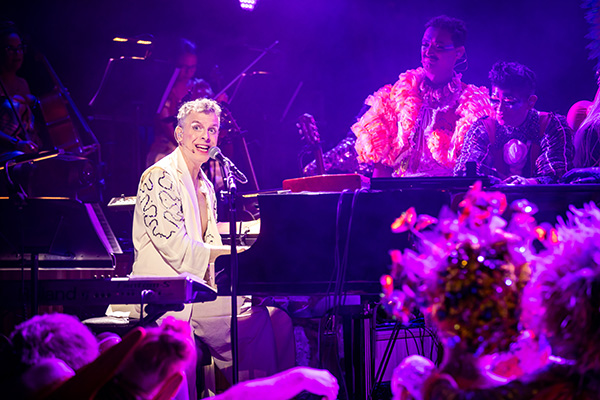
Matt Ray, Taylor Mac’s longtime collaborator and the composer and music director of Bark of Millions
It was during the multi-year process of putting together A 24-Decade History, according to Ray, that he and Mac became “true collaborators.” The pandemic intensified their creative relationship even further. Ray began composing to Mac’s lyrics with their acclaimed jazz opera The Hang (premiered in 2022), a retelling of the trial and death of Socrates. “I would write music and record all the parts in my studio and then send a demo to Taylor. We’d go back and forth like that. Along the way, I started getting lyrics for this other project. As soon as we finished The Hang, we jumped into Bark of Millions.”
Ray points out that while Mac is at heart “a creature of the theater, I come from the music world and was a gigger, toiling away in bars and nightclubs playing keyboards with jazz bands and doing the occasional tour. The more I got pulled into theater, the more I started to understand there was a larger collaborative world out there.” He considers his ongoing work with Mac “the best creative relationship of my life. We’re always stimulating each other, always thinking, always wondering about what’s possible. Taylor makes the impossible seem possible.”
Ray shares with Mac an omnivorous curiosity: “Both of us constantly consume information, and then rearrange it and expunge it.” He adds that they have in common “a highbrow-lowbrow sense of humor” as well as “our little obsessions.” Ray’s songwriting in Bark shows the influence of “everything I grew up with.” Its sound world comprises a spectrum of American styles, with Ray performing on piano and keyboards with a touring band. The singers include such distinctive artists as Thornetta Davis (“Detroit’s Queen of the Blues”), drag personality Le Gateau Chocolat, Jack Fuller (who commands a five-octave range), and the “gender-transcendent diva” Mama Alto, among others.
Although the revolutionary moment of Stonewall in 1969 is posited as the embarkation point, the queer figures represented in Bark of Millions range across the planet, from the beginning of time to the present. Mac explains that the notion of starting with Stonewall “was just a private organizing principle for myself and Matt while writing the show.” According to Ray, the idea was to honor Stonewall “as a beginning of what we could say is contemporary queer history, but it’s also a bit of Taylor winking at the world”—driving home the point that, despite what the history books seem to tell us, queer people have been here since the beginning.
Figures from recent history like Marsha P. Johnson (of Stonewall fame), Bayard Rustin, James Baldwin, or Mother Flawless Sabrina are juxtaposed with others from the ancient world (Sappho and Socrates) and even mythic divinities. The show’s title alludes to an ancient Egyptian creation myth involving the progenitor god Atum, who combines male and female aspects and is reborn each morning, traversing the sky in a boat known as the “Bark of Millions of Years.” (Even Tu’er Shen, the Taoist rabbit god regarded by some as a patron of gay male love, makes an appearance.)
What criteria did Mac use to select this trans-historical, trans-cultural pageant of queer icons? “The intention was to consider queerness in song, and so I chose all these people throughout world history as a way to ground our consideration and how it could be varied,” Mac responds. “They’re not all utopian figures we want to look up to. Some of them are in fact real assholes. The show is more a consideration of queerness.”
As Geffen observes, “the spectrum of queerness Mac has brought together is an extraordinary feat. He has tried to be as all-encompassing as possible, underscoring that queerness is not a monolith, that there are many paths within it. He’s trying to give as big a picture as possible.”
Chockablock Maximalism
The epic dimensions of Bark are another Mac signature. The embrace of the large scale, of durational events, in part stems from the artist’s rejection of homogeneity. “We live in a culture that asks us to reduce ourselves to one thing. Usually, when we go to see work that has a community aspect to it, it asks us to root for one team—like a sporting game or one god in church. Art can break up the concept of homogeneity. It can complicate things.”
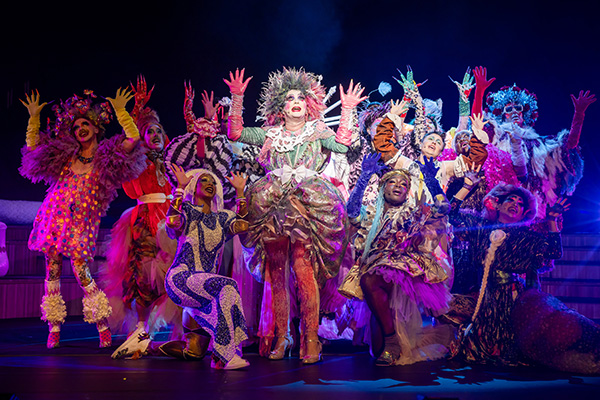
Taylor Mac (center) and the cast of Bark of Millions
That happens, in Mac’s philosophy, through the process of consideration and wonder—which requires investing time instead of quick, pre-digested consumption. When he was growing up in Stockton, his mother ran an art school that was “chockablock full of artworks in progress.” Mac is convinced this encouraged his belief that “a roomful of things actually helps you focus as opposed to dismantling your focus.”
The acceptance of multiple simultaneous stimuli and inspirations underlies Mac’s collage-based aesthetic. “The more I’m in therapy, the more I realize that the pain you feel in any given moment isn’t just that pain. It’s all that historical pain. ‘What’s hysterical is historical.’ There is a real sense that all of the sex, joy, pleasure, and celebration, all of the artistic ideas around queerness—these are available to us. You lose sight of them sometimes, but if you focus in on certain aspects, it opens up a whole history to you.”
By nature averse to tags and categorizations, he has come to accept the label “maximalist” with wry bemusement: “Minimalism is in it, whereas minimalism doesn’t have maximalism. I don’t want a homogeneous experience and I don’t want, as a queer person, to feel like I always have to be large and I always have to be maximalist.”
Bark of Millions thus contains moments of great intimacy within its extravagance of time, of staging, of musical expression, of costume and choreography. The image of simply “hanging out” is another favorite expression. “A longer show allows you to express the full range of a thing,” Mac says. “Every so often in the show, I like to get as small as I possibly can. I want the audience to feel like we are hanging out and experiencing each other, being spontaneous with each other. Part of the art of it is the hang of it.”
Costumes and Choreography
Bark of Millions also reflects the intensely collaborative aesthetic Mac has developed with his colleagues. Along with his songwriting partner Matt Ray, he enlisted members of the creative team he has worked with for years. Costume designer Machine Dazzle (aka Matthew Flower) wonderfully complements his sensibility of “queer maximalism” (to quote the title of his first solo exhibition last year at the Museum of Arts & Design in New York).
Machine Dazzle describes his role in creating costumes for Bark as follows: “I’m providing a tree for the songbirds to inhabit, nest, and fly in and around. The costumes change throughout and get smaller and less grand as the show itself builds and gets more grand, one icon at a time.” Over the course of the show, there is an overall transformation toward “less costume and more skin.”
Rather than attempt to represent a specific figure through visual cues, Dazzle says that he is more interested in having a performer “wear something ‘other.’ Other means undefinable, questionable, not this or that, something we can’t exactly figure out. Queerness is expressed through unusual silhouettes, surprises, unapologetic forms and flesh. Shapes that are both familiar and unfamiliar share space and provide a human skyline that is both tangibly whimsical and fantastically earthy.”
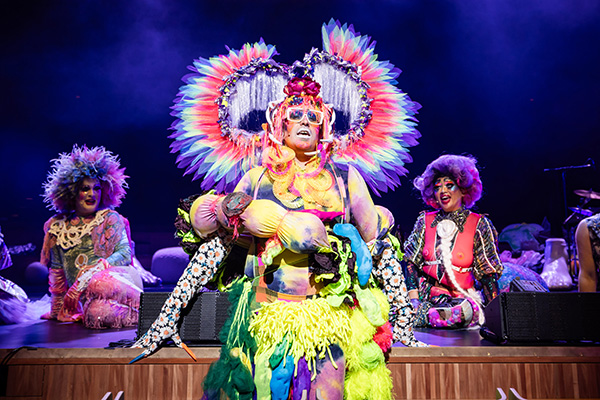
Machine Dazzle, Taylor Mac’s longtime collaborator and the costume designer of Bark of Millions
It’s no surprise that dance is an integral component of Mac’s theatrical extravaganzas. Bark of Millions is, on one level, “a hunt for something authentically queer,” as Mac puts it. “Exploring that through song does something physically, because song is really just vibration.”
Faye Driscoll, a linchpin of the show as its choreographer and co-director, recalls the questions that helped her form “conceptual frames” when she was designing Bark’s dance dimension: “Some of the practices we did early on were more like inquiries: what is a queer gesture? What is one that perhaps we saw in the world and mimicked and imitated in order to connect to a community? What is one, like a swish of the hips, perhaps in a male-bodied human, that might incur rejection? How is gesture gendered? What are gestures we might gift to the future?”
She sought a choreography that would “illuminate what’s already occurring inside the music and sometimes pull out more playful aspects or undertones or subtleties. When to get fun and playful and flamboyant and wild. How can our eccentricity be actually deeply strange, not just kind of Queer Eye for the straight guy—these ways in which queerness has become a part of our marketing and capitalist machine?” Driscoll says she was inspired by Mac’s insistence that “we are seeking and wondering about what it means to inhabit a queer spirituality, that we are doubting where we are not in certainty.”
Producing the Unconventional
Another layer of the complex art that a Taylor Mac show entails remains hidden behind the scenes: the art of producing a work of independent theater with such unusual parameters, under impossible odds and pressures. Mac singles out his creative production team at Pomegranate Arts—a frequent artistic collaborator with Cal Performances—as unsung heroines “who are doing something that nobody else is doing in the industry.”
Pomegranate Arts founder Linda Brumbach says she relishes “the challenge of helping to bring work that changes the way we think about the world to fruition.” The imperative to follow an artist like Mac means there is no “conventional investor model” to follow. “The key is looking deeply into the world and finding your village to help lift the work and stay the course. This is community … with all its complexities, deep joy, and resilience.”
Alisa Regas, managing director of Pomegranate Arts, points out that “creative producers play a vital role in making possible work that has existed and might need to exist outside institutional structures.” A central challenge with producing Bark of Millions has been to find ways “to bring this very diverse group together, which comes from many different frames of reference. As a producer, you have to think a lot about the audience and the institutions you’re working with, but especially about the artists who are trying to create their best work.” The fact that these are unique individuals “with very different needs and backgrounds and ways of expressing their artistry and at the same time part of this community” requires careful attention to every step along the way of bringing a show like Bark of Millions to the public and to the stage.
What no one—neither performers, producers, nor audiences—can rely on are simple formulas or predictable patterns when dealing with such an exuberantly innovative, anti-consumerist, anti-naturalist way of making art.
“I’m much more interested in mystery right now than I am interested in knowing things,” Mac emphasizes. Elsewhere, in a personal artistic credo, he has stated: “I believe my job as a theater artist is to remind my audience of the range of their humanity. I believe the more personal risk I take in the work, the more the audience will relate and see the whole of their humanity reflected back at them.”
“We’ve all been oppressed by people trying to oppress queerness,” adds Mac. “Straight people and cis people are oppressed by that as well.” Bark of Millions is “an invitation for people to let go of the way that they oppress or have oppressed themselves. If it’s liberating for you, then you don’t have to clamp down on other human beings and you don’t have to clamp down on yourself in order to clamp down on other human beings. So it is about trying to expand our understanding of humanity.”


